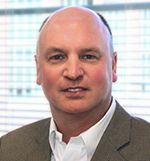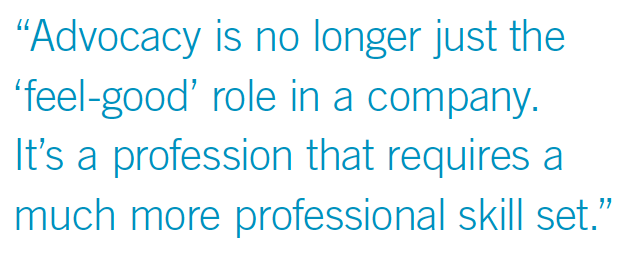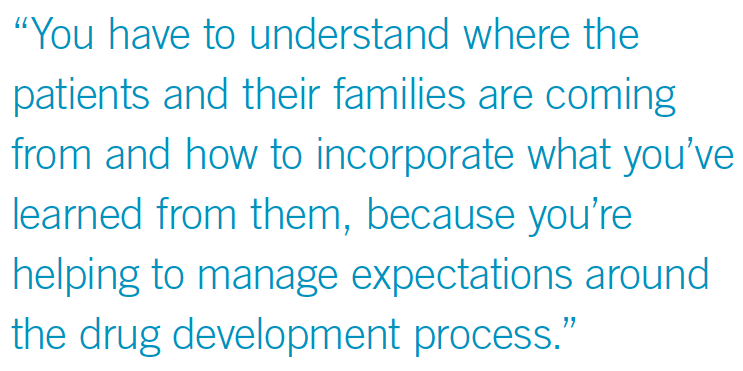Patient Advocacy: The Corporate Mandate
Pharmaceutical Executive
Perspectives from big pharma and the rare disease space on how patient advocacy is evolving as a corporate function.
Patient-advocacy leaders from big pharma and the rare disease space offer perspectives on how this area is evolving as a corporate function
The recent emergence of the chief patient officer or the chief patient advocate (or equivalent role) has seen pharma further acknowledge and coordinate its efforts to embrace the growing empowerment, sophistication, and influence of patient organizations across many disease areas, both common and rare. But while some companies are more advanced than others in embedding and optimizing patient advocacy within their corporate cultures, it remains a burgeoning function still making its way toward standardization and broad acceptance.
To explore how the function has evolved, both at large and smaller companies, and to see where it is heading in a landscape increasingly defined by patient centricity, Pharm Exec talked to three patient-advocacy leaders to trace their journeys through the industry and discuss the qualities and skills needed to succeed in their roles.
Communicating science
Dr. Joel Beetsch, vice president of patient advocacy at Celgene, has been involved with patient advocacy for around 12 years, but his career started at the bench-“relatively far away from the patient.” He trained as a cellular scientist and expected to continue with bench research when he joined the industry over 20 years ago. Until then, working in clinical departments in a hospital environment, he had seen patients “but never really felt close to them.” Moving into medical liaison and clinical trial roles, however, allowed him to edge closer to understanding their needs. Prior to joining Celgene, he was drawn to an advocacy role at Sanofi
Joel Beetsch

that bridged the gap between the company’s R&D activities and its corporate messaging, which led to patient-specific work in oncology and other areas. Now, in his role at Celgene, Beetsch explains, he “speaks with patients and advocates on a daily basis.”
Beetsch’s work revolves around establishing long-term partnerships with professional and patient organizations and working to better understand and identify the unmet needs of patients. Structurally, his responsibilities are multifold. His group engages in therapeutic-related outreach efforts to patient and professional organizations and coordinates all of the company’s community outreach efforts-in the Tri-state area of New York, New Jersey, and Connecticut, and at sites in Boston, Seattle, San Francisco, and San Diego-and is responsible for all donations, sponsorships, and granting mechanisms that fall outside of medical education. It also works with patient assistant foundations in the US.
Beetsch has observed the evolution of patient advocacy across the industry and within the advocacy community itself. Regarding the latter, he says, “the willingness and the desire to work with biopharmaceutical companies has increased certainly in the US, and there has been guidance measures and guard rails put in place across the world that have allowed us to do more of that outside the US.” On the industry side, “the focus has been to really understand the importance of engaging the patient and professional community in your everyday business all across the lifecycle, from early development to loss of exclusivity.”
Noting that Celgene was already very patient-focused and engaged with the advocacy community when he joined, Beetsch explains that his role has been “to build on that foundation, to help put a department in place, to demonstrate effectiveness within the patient community, and show those results that both reflect the benefit to the patient organization and to the company.”
Understanding the power of communities
Jessica Riviere, senior director of global patient advocacy at Biogen, started her journey toward the patient advocacy function working for Senator Ted Kennedy in the 1990s, during the Clinton healthcare-reform era. “I was working with a lot of organizations and communities and I came to appreciate and value the power of communities to make change and impact public policy and the greater good,” she told Pharm Exec.
Riviere points specifically to the HIV community, which at that time was a “trailblazer and really revolutionized patient advocacy.” She later worked again with the HIV community as director of advocacy and policy for HIV/AIDS and viral hepatitis at Bristol-Myers Squibb. “At lot of what we see in patient advocacy today came from the HIV community,” Riviere explains. “They were always super-focused on what their asks were when partnering with industry and other stakeholders. If you look now at advocacy in oncology and some rare diseases, for example, they’ve taken many pages out of the HIV action plan.”
On her Biogen appointment, Riviere says, “I think it was the first time that the company had hired a professional who had focused on advocacy to lead the team. It was a signal that the company valued patient advocacy and that it saw there was an opportunity to meet the needs we have and build a foundation for the future.”
As with Celgene, Biogen’s patient advocacy function is multi-faceted. Riviere is responsible for the overall strategy for currently marketed therapies and for those under drug discovery, and then throughout the product lifecycle. A key activity is “helping colleagues to understand the difference between an individual patient’s experience and working with a patient community,” she says. “Both are powerful, but it is the patient advocacy communities that shape and influence the environment in which the individual patient will have access to a physician, access to care and treatment, and will understand the types of services that are available to support them through their journey. Our role is working with patient advocacy groups to ensure that the drugs and many robust support programs we develop reflect the needs of the patient community.”
Rare diseases: Working at the grassroots level
Founded in 2002, Amicus Therapeutics (Cranbury, NJ) is a global biotech company focused on medicines for rare metabolic diseases. It has one globally commercialized drug for Fabry disease, an investigational enzyme replacement therapy in late-stage development for the treatment of Pompe disease, and a gene therapy pipeline for lysosomal storage disorders. The “patient-dedicated” company is headed by John Crowley, who himself became a parent advocate when two of his children were diagnosed with Pompe disease in 1998 (see Q&A here). Crowley, then a BMS executive, went on to cofound Novazyme Pharmaceuticals, a biotech startup conducting research on a new experimental treatment for Pompe disease. Novazyme was acquired in 2001 by Genzyme Corporation (now Sanofi Genzyme), where Crowley continued to play a lead role in the development of a drug for Pompe disease and joined Amicus as Chairman and CEO in 2005.
Amicus’ chief patient advocate, Jayne Gershkowitz, joined the company soon after, having known Crowley for several years from the nonprofit work she did as the executive director of the National Tay-Sachs & Allied Diseases (NTSAD) Association, which serves the lysosomal storage disorder community. She describes her primary activity at Amicus as “setting the tone for the company culture of commitment and dedication to patients and their families, not only externally but internally, and ensuring that the patient perspective is incorporated across everything that we do.”
Jayne Gershkowitz

By being close to the patient community, providing programs and services and initiatives that help individuals as well as organizations to be better educated, she explains that Amicus aims to help patients to be more empowered and be their own best advocates. “It is also about being the conscience of the company,” she told Pharm Exec. “Keeping everybody mindful of why we do what we do and who we do it for.”
Patient advocacy in the rare disease space is “very grassroots,” Gershkowitz says. “In many cases, for example, it’s about parental advocates finding somebody who is interested enough to take on their child’s disease in the lab. There’s a very small number of both basic and clinical researchers, and not many companies involved on the industry side. So, partnerships naturally ensue. Without these multi-stakeholder partnerships, sometimes the work needed for rare diseases would not be able to move forward.”
Gershkowitz notes that patient & professional advocacy (P&PA) at Amicus has grown into something that is “a model for many other companies.” Amicus has a global P&PA team of 11 people, which “is among the largest teams in biotech, if not the largest.” Among the team is a genetics nurse, an attorney with a public affairs background, a pharmacist, and a medical social worker, to name just a few. “They bring all different skills and experience,” Gershkowitz adds. “We work very hard at ensuring that we speak in a consistent way across all of our key audiences. Everything that goes into our early work, from our clinical trials to marketing and commercialization is informed by what we learn from patients, their caregivers, and communities.”
Advancing advocacy
Gershkowitz sees the value that patient advocacy has brought to the rare disease space moving increasingly into the common disease space. But there are still areas around the standardization of the function-and where it sits in an organization-where some of the bigger companies could take inspiration from their smaller, rare-disease-focused counterparts. At Celgene, like many drugmakers, patient advocacy sits within corporate affairs, but here it serves as a kind of shared-service function across all elements of the company, from R&D to late-stage commercialization.
“What I like about the structure we have,” says Beetsch, “is that we are shared amongst everybody and we occupy an elevated platform. The patient advocacy team is in high demand; we are very cross-functional within the team and across corporate affairs, and ultimately across the company.”
In other companies, however, patient advocacy may be more aligned with government affairs and public policy, medical affairs, community relations, or it may sit within the commercial business. And in terms of the standardization of the role, as Riviere points out, “there is still work to be done.” She explains: “We’re better than where we were 10 years ago, but I don’t think there is really any standardization. If you’ve seen one patient advocacy function at a company, you’ve seen one patient advocacy function at a company! It’s not like medical affairs or marketing, where every company has a variation on the same thing. You cannot say that about patient advocacy yet, so I am hoping that we move to a broader understanding of its value and impact.”
Beetsch acknowledges some of the challenges that larger companies may have. For example, he explains, “they can have two different types of patient advocacy organizations. One might be in a center of excellence within their R&D community that is really working to recruit clinical trials. Then there’s a separate function that is more associated with the business. Often, those two functions within the same company don’t communicate regularly with one another. At Celgene, we are fortunate that we are allowed to do all of that within one department-we have to talk to each other because we all work with each other.”
At Amicus, P&PA is positioned as an independent, product-agnostic function, reporting directly to the CEO and working directly with functions all across the company “right through to facilities, legal, and compliance.” Gershkowitz says: “We are structured as one cohesive team. Everyone is central; they may have their main area of focus but the work we do is both disease-specific and overarching. It made sense to become a standalone function because for a company to be truly patient-dedicated-that’s a term that I prefer to ‘patient centricity’-then patient advocacy deserves to sit at the table as any other strategic function.”
Gershkowitz states that the field of patient advocacy is burgeoning, however. She would like to see more companies embrace advocacy as an integral function, “so that it rises with even more corporate structures.” To that end, she has been active in providing more educational opportunities in advocacy. She helped to cofound a nonprofit organization, Professional Patient Advocates in Life Sciences (PPALS, ppals.org), which, in conjunction with Sanford Research Institute, created the Patient Advocacy Certificate Training (PACT) course of study “for health and life science professionals and leaders of patient advocacy organizations to enhance their professional development.” The program serves to “help people see advocacy as a career choice and to give them some grounding in it. It’s about validating the arrival of patient advocacy in life sciences,” says Gershkowitz. “We’re about to start our fourth year of face-to-face courses, and we’re

looking to develop a master’s program at an independent academic institution. We want to move this discipline forward and bring more people to the field. Historically, patient advocacy as a professional role has not been supported by a dedicated course of study. Now, it is.”
It’s important to help more people find advocacy as a career choice, adds Gershkowitz. “My team comes from many different professional experiences, and that’s a perfect example of how people come to advocacy. It’s circuitous. What we’re seeing now is people seeking out a career in patient advocacy, as opposed to coming to it via any number of different roles in medicine, healthcare, or corporate drug development.”
Riviere notes that advocacy is “no longer about saying, ‘Hey, I like working with patients.’ It’s no longer just the ‘feel-good’ role in a company. It’s a profession that requires a much more professional skill set.”
Key skills
So, what does it take to succeed in the pharma patient advocacy function? Beetsch says it is helpful to have customer management experience, along with some level of clinical or scientific background. “It’s always useful if people understand the science and can communicate in terms that patients and patient organizations can understand.” He also looks for people with experience working in the early pipeline space. “The reason for that is that we are working hard to put that patient voice into all elements of our development process.”
For Riviere, people working in patient advocacy roles need to be strategic, able to work with diverse communities and to listen to them, to build relationships over long periods of time, and to agree to disagree on certain issues and find common ground on others. “I look for people who are passionate, determined, and intuitive, who are forward-thinking and can look over a longer horizon,” she explains. “There is not a huge growth curve in patient advocacy roles; you’re not suddenly going to be the president of a biotech company if you started out in patient advocacy. These are roles that people often stay in for years, much like government affairs and public policy roles.”
“Clearly, empathy and creativity are essential,” says Gershkowitz. A key quality is the ability to strike a balance between flexibility and assertiveness, working with different communities that have distinct needs

but also needs that are common to other rare diseases. “You have to understand where the patients and their families are coming from and how to incorporate what you’ve learned from them, because you’re helping to manage expectations around the drug development process and about where the company is at any one point in time,” she says. “You have to be able to assertively and appropriately message that back to the community. With that balance, I think, one is able to strike trust.”
The road ahead
Pharma’s patient advocates are increasingly facing up to the challenges relating to disease awareness, access to innovation, and reimbursement that patient groups have been talking about for years. The ability to work side-by-side with patient organizations is essential to improving the industry’s efforts, says Beetsch. “They have the ear of governments, payers, and professional societies, which often the industry does not have. To be able, through forums like the European Patients’ Academy (EUPATI) and the Clinical Trials Transformation Initiative (CITI), to sit at the same tables as the patient community and learn from each other, learn how to do things better, is a great opportunity.”
While industry–patient groups’ relationships will continue to be scrutinized, pharma’s engagement with advocacy groups “is as beneficial to them as it is to us,” says Riviere. “We recognize their independence as organizations. There are plenty of places where we can partner to have a substantive impact, and other places where it is appropriate not to partner.”
Ultimately, says Gershkowitz, pharma’s patient advocacy function “is being increasingly recognized for the intrinsic value that it brings to the drug development process, regardless of where it is in the continuum.” She adds, “I’m looking forward to seeing more of that growth.”
Julian Upton is Pharm Exec’s European and Online Editor. He can be reached at julian.upton@ubm.com

The Misinformation Maze: Navigating Public Health in the Digital Age
March 11th 2025Jennifer Butler, chief commercial officer of Pleio, discusses misinformation's threat to public health, where patients are turning for trustworthy health information, the industry's pivot to peer-to-patient strategies to educate patients, and more.